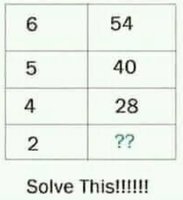GadgetJim57
New member
- Joined
- Jul 7, 2020
- Messages
- 1
*** Math Puzzles: I found this math puzzle. I know how to get the correct answer, but I need help to explain respectfully to a friend how to get the correct answer. This is what they wrote for their answer .....
It could be this...
6 x 9 = 54
5 x 8 = 40
4 x 7 = 28
3 x Y = Z
2 x 5 = 10
-- But then the answer would NOT be following the GIVEN PATTERN and this puzzle would become like a woman who is not being direct.
-- 1) this puzzle IS NOT ASKING you to fill in a missing grid, SO THAT CANNOT BE ALLOWED! PERIOD!
-- 2) This puzzle IS asking you to find a pattern WITH AND ONLY WITH THE EXISTING information, not by adding to it.
-- 3) inserting something into this would be adding to the MATH PUZZLE WHICH CANNOT BE ALLOWED BECAUSE THAT IS NOT the scientific way and that derails away from EXACTLY what the equation is asking. (It is ONLY asking for the next number, nothing more and nothing in between!)
-- 4) the scientific way is to answer only the question in which you are asked.
-- 5) if the puzzle wanted another grid row, then it should've been written EXACTLY LIKE THIS: ("make this pattern complete by inserting steps in order to discover the missing "??"
-- 6) if the puzzle didn't read those exact words VERBATIM, then it is a puzzle WRITTEN BY A PRESCHOOLER WHO ADDS THE RULES AS THEY GO ALONG. SIMPLE AS THAT.
Don't tell me they wanted you to add an extra row. Cuz THAT'S NOT AT ALL what they asked for!
It could be this...
6 x 9 = 54
5 x 8 = 40
4 x 7 = 28
3 x Y = Z
2 x 5 = 10
-- But then the answer would NOT be following the GIVEN PATTERN and this puzzle would become like a woman who is not being direct.
-- 1) this puzzle IS NOT ASKING you to fill in a missing grid, SO THAT CANNOT BE ALLOWED! PERIOD!
-- 2) This puzzle IS asking you to find a pattern WITH AND ONLY WITH THE EXISTING information, not by adding to it.
-- 3) inserting something into this would be adding to the MATH PUZZLE WHICH CANNOT BE ALLOWED BECAUSE THAT IS NOT the scientific way and that derails away from EXACTLY what the equation is asking. (It is ONLY asking for the next number, nothing more and nothing in between!)
-- 4) the scientific way is to answer only the question in which you are asked.
-- 5) if the puzzle wanted another grid row, then it should've been written EXACTLY LIKE THIS: ("make this pattern complete by inserting steps in order to discover the missing "??"
-- 6) if the puzzle didn't read those exact words VERBATIM, then it is a puzzle WRITTEN BY A PRESCHOOLER WHO ADDS THE RULES AS THEY GO ALONG. SIMPLE AS THAT.
Don't tell me they wanted you to add an extra row. Cuz THAT'S NOT AT ALL what they asked for!

